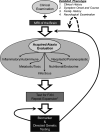Childhood cerebellar ataxia
- PMID: 22764177
- PMCID: PMC3490706
- DOI: 10.1177/0883073812448231
Childhood cerebellar ataxia
Abstract
Childhood presentations of ataxia, an impairment of balance and coordination caused by damage to or dysfunction of the cerebellum, can often be challenging to diagnose. Presentations tend to be clinically heterogeneous, but key considerations may vary based on the child's age at onset, the course of illness, and subtle differences in phenotype. Systematic investigation is recommended for efficient diagnosis. In this review, we outline common etiologies and describe a comprehensive approach to the evaluation of both acquired and genetic cerebellar ataxia in children.
Figures



References
-
- Fogel BL, Perlman S. Cerebellar disorders: Balancing the approach to cerebellar ataxia. In: Gálvez-Jiménez N, Tuite PJ, editors. Uncommon Causes of Movement Disorders. 1st ed Cambridge University Press; 2011. pp. 198–216.
-
- Fogel BL, Perlman S. An approach to the patient with late-onset cerebellar ataxia. Nat Clin Pract Neurol. 2006;2:629–635. quiz 1 p following 635. - PubMed
-
- Klockgether T. Sporadic ataxia with adult onset: classification and diagnostic criteria. Lancet Neurol. 2010;9:94–104. - PubMed
-
- Brusse E, Maat-Kievit JA, van Swieten JC. Diagnosis and management of early-and late-onset cerebellar ataxia. Clin Genet. 2007;71:12–24. - PubMed
Publication types
MeSH terms
Grants and funding
LinkOut - more resources
Full Text Sources

